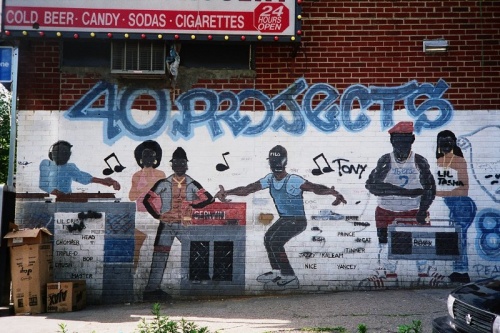Views
Contents |
Notable Sites
Past
Jamaica Racetrack
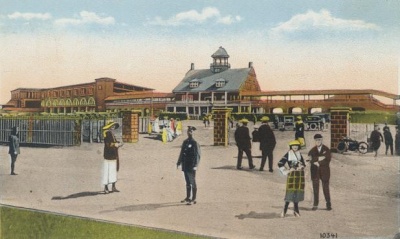
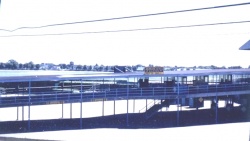
Jamaica Racetrack was an American Thoroughbred horse racing facility opened by the Metropolitan Jockey Club. The Metropolitan Jockey Club opened the track on April 27, 1903 with fifteen thousand persons in attendance[4]. The one-mile, oval track housed thoroughbred horse racing and was reputed to be extremely fast due to a superior drainage system. The complex featured 9,000 grandstand seats and an open field intended for additional seating.
One of the tracks founder's and former president, was Eugene D. Wood for whom the Wood Memorial Stakes, a horse race run today at the Aqueduct Racetrack, is named. Legendary Hall of Fame horse trainer Sunny Jim Fitzsimmons was the first to train at Jamaica Racetrack and Native Dancer made a winning debut here on April 19, 1952. The facility set its maximum attendance record on Memorial Day 1945, housing 64,679 spectators. Unfortunately, Jamaica Racetrack deteriorated over time; it closed on August 1, 1959. Today Rochdale Village is located on the former site of the Jamaica Racetrack.
Present
Rochdale Village
Rochdale Village is the second largest housing co-operative in the US. It is comprised of 20 fourteen-story apartment buildings on the 170-acre site[6]. When Rochdale Village opened in South Jamaica in late 1963, it was the largest housing cooperative in the world[7]. Though South Jamaica was a predominantly black community, at least 80% of the original families in Rochdale were white. A majority of whom were Jewish. During the 70's and early 80's, white residents moved to the suburbs, leaving the complex with empty apartments[8]. Under new management, Rochdale has become a preferred residence for middle-class black people. In 1997, there were only nine vacancies.
Today Rochdale Village is referred to by residents as "The Jewel of Jamaica"[9]. Rochdale was designed to be a "city within a city". Thus, in addition to its thousands of apartments, it includes a power plant (providing electricity, heat and air-conditioning all included in the carrying charges), two shopping malls, two supermarkets, two drug stores, and an assortment of others amenities. Also included is a community center, post office, a public library branch, and a New York Police Department precinct. Rochdale Village is also surrounded by three schools, PS 30, PS 80 and JHS 72. Some of the major highways/transportation methods are the Belt Parkway, MTA New York City Transit buses and the Long Island Rail Road, which stops right by the complex at the Locust Manor station
To learn more of Rochdale Village, click here
AirTrain JFK
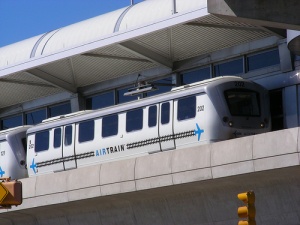
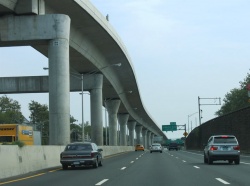

One of the most notable sites along the borders of South Jamaica is that of AirTrain JFK. It is a notable site seen running on elevated tracks over the Van Wyck Expressway. AirTrain JFK is an 8.1-mile people mover train system in New York City that connects John F. Kennedy International Airport to the city's subway, commuter trains and airport parking lots.
According to the AirTrain JFK brochure, "AirTrain JFK is the affordable alternative to driving. AirTrain JFK is the easiest way to, from, and around John F. Kennedy International Airport. Developed by The Port Authority of New York and New Jersey, AirTrain JFK runs 24 hours a day, every day and provides easy connections with MTA New York City Transit subways and buses, and the Long Island Rail Road (LIRR). AirTrain costs just $5 with a Pay-Per-Ride MetroCard as you enter or exit the system at the Jamaica or Howard Beach stations. Children under 5 ride free. MTA and LIRR fares are not included. The service is fast—trains travel from the Jamaica or Howard Beach stations to JFK’s Terminal 8 in less than 20 minutes"[13].
Historical Landmarks
St. Monica's Church
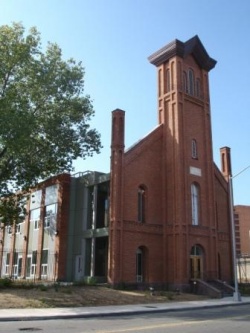
Saint Monica's is one of the oldest surviving examples of Early Romanesque Revival architecture in New York, and one of the few Roman Catholic churches in the city executed in this style[15]. It is owned by New York State and now located on the campus of York Community College. Former New York Governor Cuomo attended the church growing up.
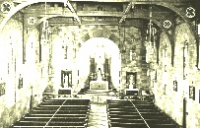

St. Monica's Church was built by master mason Anders Peterson, a Danish-born contractor who later built the First Reformed and Grace Episcopal Churches in Jamaica, under the supervision of the Reverend Anthony Farley in 1856[18]. The construction of St. Monica's began when in the 1830's the construction of the Long Island Rail Road attracted Irish Catholic laborers, and in 1838 St. Paul's, which was built in Brooklyn in 1822, established a mission in Jamaica. A frame building was built in 1840 and the new St. Monica's sent its own missions out to other communities. The potato famine in the 1840's increased Irish emigration and St. Monica's flourished. A new church was built, just south of the L.I.R.R. tracks at what is now 94-20 160th Street.
The church was designed as a red brick Romanesque Revival-style building with a tall central campanile and an Italian flavor. Slender pilasters outlined in brick give the structure an impression of height beyond its actual size. Delicate brick corbelling on the top of the side walls produces much of the building's modest decoration. The inside was a great open hall, apparently plain in finish although twice redecorated in much higher style, in 1893 and in the 1930's (Mario M. Cuomo was an altar boy there in the 1940's).
By the 1960's downtown Jamaica was aging and much of it was considered blighted. A large area of small shops and houses between 150th and 165th Streets were condemned to make way for York College. There were no plans ever called for the actual demolition of St. Monica's, but the diocese took the opportunity to close the church. The last service was held on June 24, 1973.
The city then acquired the property without specific plans for the building. It did not seal or protect the structure and soon vandals stripped off the copper gutters, broke the stained-glass windows and removed the copper dormers on the roof.
After the state took over the CUNY system in 1978, Henry F. Ludder Jr., a local preservationist, led an unsuccessful campaign to stabilize and renovate the deteriorating building. By the time the windows and doors were bricked up in 1978 the interior was a shambles. Although St. Monica's was designated a landmark in 1979 the state never appropriated the $300,000 to $500,000 then estimated needed to convert the building to an assembly hall.
Since the church went unprotected 1973, there had been extensive decay and water damage to St. Monica's. The roof retreated so much that it would dump rain into the sidewalls, which would bulge and buckle and was on the verge of collapsing. In 1990, the cost of making it usable was $3 million. Today only a facade of the original building remains. It has been incorporated into a modern day-care center on the York College campus.
See Also
Return to Main Page
References
- ↑ Allen Lloyd, "40's Projects. South Jamaica Queens.," Allen Lloyd, PBase, http://www.pbase.com/allenmood1/image/85997025 (accessed April 25, 2009).
- ↑ c. 1907 Post Card of Jamaica Racetrack at http://arrts-arrchives.com/newpage6race.html
- ↑ Bill Rugen, "Photo of Jamaica Racetrack," August 1959, ARRT'S ARRCHIVES, http://arrts-arrchives.com/images3/LIJRT6.jpg (accessed April 25, 2009).
- ↑ New York City Department of Parks & Recreation. "North Rochdale Playground." New York City Department of Parks & Recreation. http://www.nycgovparks.org/sub_your_park/historical_signs/hs_historical_sign.php?id=7911 (accessed April 25, 2009).
- ↑ http://www.flickr.com/photos/35235829@N03/sets/72157613675257640/
- ↑ New York City Department of Parks & Recreation. "North Rochdale Playground." New York City Department of Parks & Recreation. http://www.nycgovparks.org/sub_your_park/historical_signs/hs_historical_sign.php?id=7911 (accessed April 25, 2009).
- ↑ Eisenstadt, Peter. (2007, July 1). Rochdale Village and the rise and fall of integrated housing in New York City The Free Library. (2007). Retrieved April 16, 2009 from http://www.thefreelibrary.com/Rochdale Village and the rise and fall of integrated housing in New...-a0165359504
- ↑ LeDuff, Charlie. "NEIGHBORHOOD REPORT: ROCHDALE VILLAGE; Rat Problem: Rats or No Rats?" The New York Times, September 28, 1997, New York Edition edition. http://www.nytimes.com/1997/09/28/nyregion/neighborhood-report-rochdale-village-rat-problem-rats-or-no-rats.html (accessed April 25, 2009).
- ↑ ROCHDALE VILLAGE. "About ROCHDALE VILLAGE." ROCHDALE VILLAGE. http://www.rochdalevillage.com/aboutrochdalevillage.html (accessed April 25, 2009).
- ↑ Flickr User cerdsp, "NYC - JFK Airport - Airtrain," Flickr, http://www.flickr.com/photos/15434282@N00/2906785196/ (accessed April 25, 2009).
- ↑ AAROADS, "An elevated rail line follows the centerline of Interstate 678 between 94th Avenue and JFK International Airport in south Queens.," August 29, 2005, AAroads.com, http://www.northeastroads.com/new_york400/i-678_sb_exit_004_02.jpg (accessed April 25, 2009).
- ↑ Flickr User shooGu, "Jamaica-JFK AirTrain," Flickr, http://www.flickr.com/photos/suman_ganguli/3073321487/ (accessed April 25, 2009).
- ↑ The Port Authority of NY & NJ. AirTrain JFK. http://www.panynj.gov/Airtrain/pdfdownload/jfk_brochure_english.pdf (accessed April 25, 2009).
- ↑ "Greater Jamaica Development Corporation," Greater Jamaica Development Corporation,http://www.gjdc.org/downtown/art/thumb_stmonica.jpg (accessed April 24, 2009).
- ↑ Gray, Christopher. "Streetscapes: St. Monica's Church; An Elegant Romanesque Edifice Ruined by Neglect." The New York Times, July 1, 1990, New York edition. http://www.nytimes.com/1990/07/01/realestate/streetscapes-st-monica-s-church-an-elegant-romanesque-edifice-ruined-by-neglect.html?scp=2&sq=St.%20Monica%27s%20Church&st=cse (accessed April 24, 2009).
- ↑ James Driscoll, "St. Monica's Church 1936," Preserve & Protect, http://www.preserve2.org/qpl/s96pt2.htm (accessed April 24, 2009).
- ↑ James Driscoll, "St. Monica's Church 1996," Preserve & Protect, http://www.preserve2.org/qpl/s96pt2.htm (accessed April 24, 2009).
- ↑ Jamaicafunk.org. "Local Landmarks." Jamaicafunk. http://www.jamaicafunk.org/djcd/jamaica/history/landmarks/ (accessed April 24, 2009).
